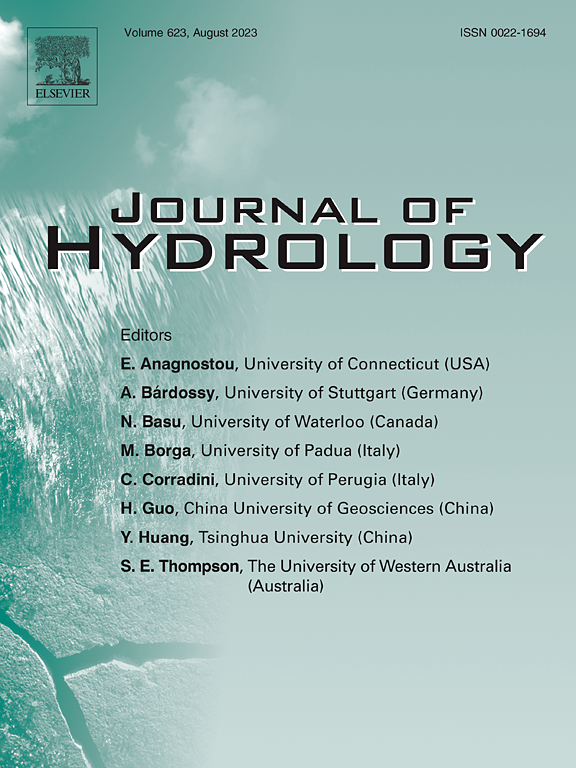Evaluating and modeling rill detachment and resistance in different rates and particle sizes of biochar application on the Loess Plateau of China
IF 5.9
1区 地球科学
Q1 ENGINEERING, CIVIL
引用次数: 0
Abstract
The application of biochar can modify soil physicochemical properties, thereby influencing soil detachment capacity (Dc), rill erodibility (Kr) and critical shear stress (τc). However, the effects of biochar particle size on Dc, Kr and τc remain unexplored. This research investigated how apple branch-derived biochar with different biochar particle sizes and rates affects Dc, Kr, τc, and quantified their relationships with soil physicochemical properties through field experiment. Undisturbed soil samples were collected from field plots treated with biochar at 0 %, 1 %, 2.5 %, and 4 %, and particle sizes of 2–1, 1–0.5, and <0.5 mm for 3 months, using steel rings to a depth of 20 cm. The Dc, Kr, and τc of these samples were evaluated using a flume experiment, where soil samples were subjected to two flow discharge rates (0.25 and 0.65 L s−1) and three slope gradients (17.63 %, 26.79 %, and 40.40 %). The results revealed that biochar application significantly reduced Dc and Kr, with the most pronounced reductions observed at the 4 % biochar rate (65 % and 174 %, respectively). Larger biochar particles (2–1 mm) were more effective in reducing Dc (64 %) and Kr (61 %) compared to smaller sizes. The total porosity (TP), cohesion (COH), mean weight diameter of soil aggregates (MWD) and soil organic carbon (SOC) were identified as critical factors influencing Dc and Kr. Power function equations effectively estimated Dc and Kr based on TP, COH, MWD and SOC under different biochar application rates. Similarly, the Dc and Kr were well predicted using power function equations incorporating SOC, soil crust hardness (SH) and >0.25 mm water-stable soil aggregate (SWA) under varying biochar particle sizes. These findings demonstrate that higher biochar application rates and larger particle sizes significantly enhance soil erosion resistance in loess soils, offering a promising strategy to mitigate rill erosion in degraded or degrading sloping farmlands on the Loess Plateau.
黄土高原不同生物炭施用速率和粒径下的细沟剥离和阻力评价与模拟
生物炭的施用可以改变土壤的理化性质,从而影响土壤的剥离能力(Dc)、细沟可蚀性(Kr)和临界剪应力(τc)。然而,生物炭粒径对Dc、Kr和τc的影响尚未研究。研究了不同粒径和速率的苹果枝源生物炭对土壤Dc、Kr、τc的影响,并通过田间试验定量了它们与土壤理化性质的关系。未受干扰的土壤样品采集自农田地块,分别以0%、1%、2.5%和4%的生物炭处理,颗粒大小为2-1、1 - 0.5和<;0.5 mm,使用钢环深度为20 cm,持续3个月。在水槽实验中,土壤样品受到两种流量速率(0.25和0.65 L s−1)和三种坡度(17.63%,26.79%和40.40%)的影响,并对这些样品的Dc, Kr和τc进行了评估。结果表明,施用生物炭显著降低了Dc和Kr,在生物炭用量为4%时,降低幅度最大(分别为65%和174%)。较大的生物炭颗粒(2-1毫米)在减少Dc(64%)和Kr(61%)方面比较小的颗粒更有效。结果表明,土壤总孔隙度(TP)、黏结力(COH)、土壤团聚体平均重径(MWD)和土壤有机碳(SOC)是影响Dc和Kr的关键因素,幂函数方程基于TP、COH、MWD和SOC有效估算了不同生物炭施用量下的Dc和Kr。同样,在不同的生物炭粒径下,利用包含SOC、土壤结壳硬度(SH)和>;0.25 mm水稳性土壤团聚体(SWA)的幂函数方程可以很好地预测Dc和Kr。研究结果表明,较高的生物炭施用量和较大的粒径可显著提高黄土土壤的抗侵蚀能力,为缓解黄土高原退化或退化坡耕地的细沟侵蚀提供了一种有希望的策略。
本文章由计算机程序翻译,如有差异,请以英文原文为准。
求助全文
约1分钟内获得全文
求助全文
来源期刊

Journal of Hydrology
地学-地球科学综合
CiteScore
11.00
自引率
12.50%
发文量
1309
审稿时长
7.5 months
期刊介绍:
The Journal of Hydrology publishes original research papers and comprehensive reviews in all the subfields of the hydrological sciences including water based management and policy issues that impact on economics and society. These comprise, but are not limited to the physical, chemical, biogeochemical, stochastic and systems aspects of surface and groundwater hydrology, hydrometeorology and hydrogeology. Relevant topics incorporating the insights and methodologies of disciplines such as climatology, water resource systems, hydraulics, agrohydrology, geomorphology, soil science, instrumentation and remote sensing, civil and environmental engineering are included. Social science perspectives on hydrological problems such as resource and ecological economics, environmental sociology, psychology and behavioural science, management and policy analysis are also invited. Multi-and interdisciplinary analyses of hydrological problems are within scope. The science published in the Journal of Hydrology is relevant to catchment scales rather than exclusively to a local scale or site.
 求助内容:
求助内容: 应助结果提醒方式:
应助结果提醒方式:


